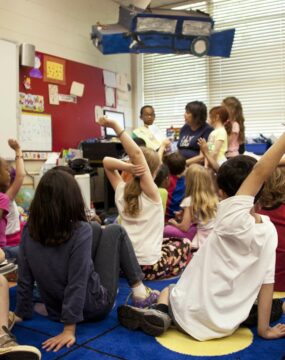Education
Keep up with our latest demographic insights

Earlier this year, we documented what we have learned so far about the pandemic’s effect on the educational system in NC. In this post, we detail how we expect data to be impacted across the education continuum, from Pre-K to career, with specific attention to 18 education indicators we monitor through the myFutureNC state dashboard. There are four main ways data can be impacted: 1. No data updates are available COVID-19 significant disrupted data collection…
On March 24th, Governor Cooper directed $51.4 million in new funding to help students access and complete postsecondary education as the state recovers from the repercussions of the COVID-19 pandemic. The funding is drawn from North Carolina’s share of the Governor’s Emergency Education Relief (GEER) fund, which are federal funds appropriated to assist educational institutions, from school districts, postsecondary institutions, and other education opportunities to reduce the detrimental impact from COVID-19. North Carolina will invest:…


The National Student Clearinghouse Research Center (NSCRC) regularly publishes research supporting education, workforce, and learner success, by identifying different student educational pathways. Specifically, the NCSRC calculates the number of high school graduates who immediately enroll in college after graduation. In March 2021, the NSCRC released a report on on-time fall college data enrollment that addressed the impact of COVID-19. This report corrected an earlier December release that said that on-time fall postsecondary enrollment had declined…


It has been a little over a year since the pandemic shut down workplaces and schools across North Carolina. In this post, we detail what Carolina Demography has learned about the pandemic’s effect on the educational system in NC. First, let’s start with a short timeline: On March 15, 2020, NC Governor Roy Cooper signed an executive order to close all K-12 public schools for a minimum of two weeks. During the next three weeks,…



Across the country, fewer students are showing up in traditional public schools because of the ongoing COVID-19 pandemic. We have looked at attendance data from the North Carolina Department of Public Instruction to understand how declines in enrollment vary across the state and which grades are impacted. How much is school attendance down? Statewide, nearly 63,000 fewer students were attending public schools in Month 2 of 2020-21 compared to 2019-20, a loss of -4.4%. Public school enrollments had been slowly declining since 2015-16, reflecting two factors


We recently worked with the Chamber for a Greater Chapel Hill-Carrboro, the governments of the Towns of Chapel Hill, Carrboro, and Hillsborough, and Orange County to streamline existing processes for acquiring, updating, and maintaining the data they use for their community reports and presentations. As part of that work, we've released a series of reports looking at demographic and economic trends in Orange County, NC. Here are some highlights from Carolina Demography's report on community…


Current FAFSA Completion in North Carolina Research has established a strong relationship between high school seniors completing the Free Application for Federal Student Aid (FAFSA) and their likelihood to attend college. FAFSA completion is also a key transition point along the educational continuum. An analysis of data from the National Center for Education Statistics shows that 88% of high school seniors who completed a FAFSA in 2012-13 had attended college by February 2016, compared to…


Adaeze Ibeanu is a rising sophomore at UNC double majoring in Psychology and Political Science. She recently started interning with Carolina Demography, where she has been monitoring legislative committee meetings that address education in North Carolina. She will continue this work when the General Assembly convenes for the long session in January. Most recently, she has researched and written a blog post about Cooperative Innovative High Schools in NC – one of which she attended…


Since office and school closures began in response to the COVID-19 pandemic earlier this year, remote workers and students across the state have been feeling the effects of decreased network speed and sputtering performance on their home networks, leading some to question whether their home internet service is up to the task of keeping them connected with remote co-workers, classmates, and professors. It has even led some policy makers to question if now is the time to reconsider whether high-speed internet should continue to be viewed as a high-tech luxury, or simply a necessity of modern life.


This blog is the second in a series exploring myFutureNC’s statewide dashboard indicators, which span the educational continuum. Read the complete series. This week, we’ll be going in depth on two similar indicators - College-and-Career-Ready in reading and math. Although we provide detailed information on NC, national data on the percent of 3-8 grade students who earned college-and-career-ready scores on End-of-Grade (EOG) reading and math exams are not available, and therefore we cannot compare North Carolina to other states. What…
Your support is critical to our mission of measuring, understanding, and predicting population change and its impact. Donate to Carolina Demography today.